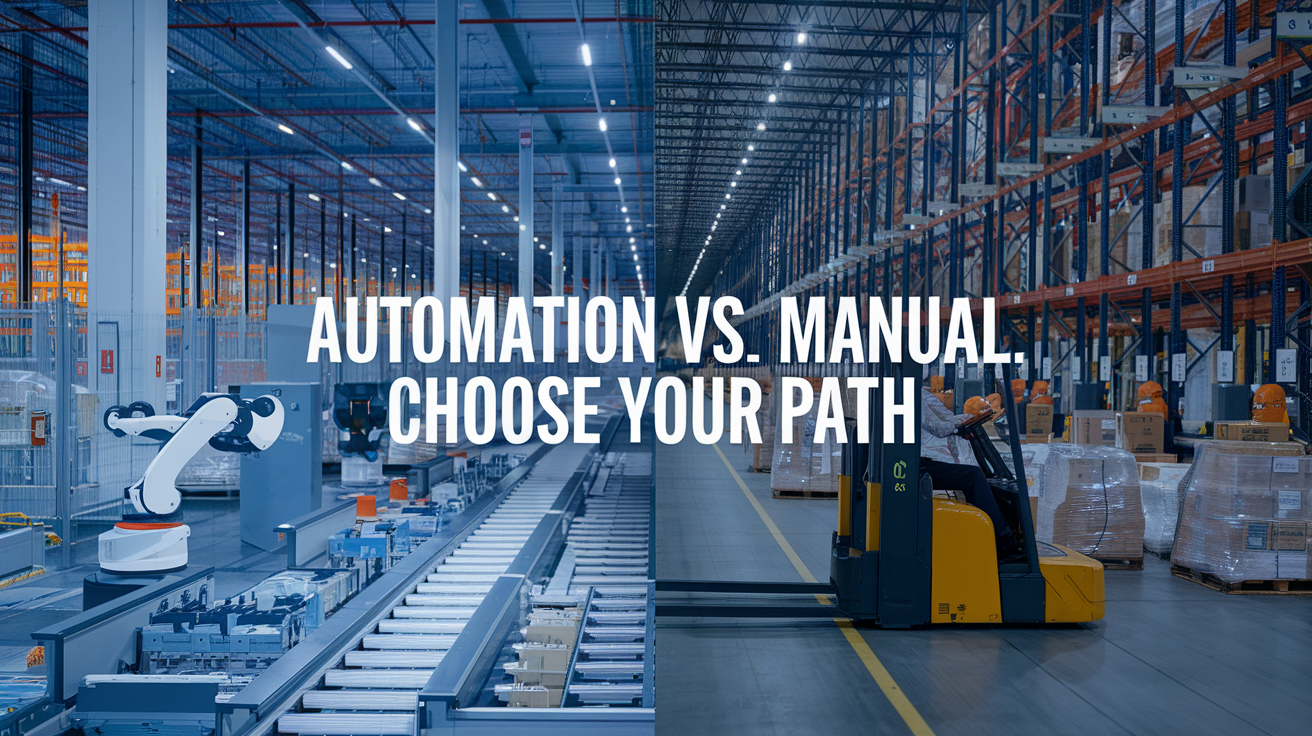In today’s fast-paced world of logistics and supply chain management, warehouse operators face a critical decision: to automate or not to automate? 🤖 vs 👨🔧 The choice between warehouse automation and manual operations can significantly impact efficiency, costs, and overall business success. But how do you know which option is right for your unique needs?
Imagine a warehouse where robots glide effortlessly through aisles, picking and packing orders with lightning speed and precision. Now, picture a bustling facility filled with skilled workers, meticulously handling each item with care and attention to detail. Both scenarios have their merits, but which one aligns best with your business goals? 🤔 In this blog post, we’ll dive deep into the world of warehouse management, exploring the pros and cons of automation and manual operations. We’ll help you navigate through crucial factors such as costs, scalability, workforce impact, and implementation challenges.
As we embark on this journey, we’ll first unpack the concept of warehouse automation and contrast it with traditional manual operations. Then, we’ll guide you through a comprehensive comparison, covering everything from ROI and scalability to the nitty-gritty of warehouse size and complexity. By the end of this post, you’ll be equipped with the knowledge to make an informed decision that could revolutionize your warehouse operations. Let’s get started! 🚀
Understanding Warehouse Automation
A. Definition and key components
Warehouse automation refers to the use of technology and equipment to streamline and optimize various warehouse processes with minimal human intervention. Key components of warehouse automation include:
- Automated Storage and Retrieval Systems (AS/RS)
- Automated Guided Vehicles (AGVs)
- Robotic Picking Systems
- Conveyor Systems
- Warehouse Management Systems (WMS)
These components work together to create an efficient and interconnected warehouse ecosystem.
B. Benefits of automation in warehouses
Implementing automation in warehouses offers numerous advantages:
| Benefit | Description |
|---|---|
| Increased Efficiency | Reduces manual labor and speeds up processes |
| Improved Accuracy | Minimizes human errors in picking and inventory management |
| Cost Reduction | Lowers labor costs and improves resource utilization |
| Enhanced Safety | Reduces workplace accidents and injuries |
| 24/7 Operation | Enables continuous operation without fatigue |
| Real-time Tracking | Provides accurate inventory data and visibility |
C. Common automation technologies
Several technologies are commonly used in warehouse automation:
- Radio-Frequency Identification (RFID): Tracks inventory and assets using radio waves
- Artificial Intelligence (AI): Optimizes routing, scheduling, and demand forecasting
- Internet of Things (IoT): Connects various devices and systems for seamless communication
- Cloud Computing: Enables data storage, processing, and accessibility from anywhere
- Machine Learning: Improves decision-making and predictive maintenance
These technologies, when integrated effectively, can significantly enhance warehouse operations and provide a competitive edge in today’s fast-paced supply chain landscape.
Manual Warehouse Operations

Traditional warehouse processes
Manual warehouse operations rely on time-tested processes that have been refined over decades. These processes typically include:
- Receiving
- Put-away
- Picking
- Packing
- Shipping
Each of these processes involves human labor and basic equipment. For example, workers use forklifts, pallet jacks, and hand trucks to move inventory. They rely on paper-based or basic digital systems for inventory management and order processing.
| Process | Description | Equipment |
|---|---|---|
| Receiving | Unloading and inspecting incoming goods | Forklifts, conveyor belts |
| Put-away | Storing items in designated locations | Pallet jacks, hand trucks |
| Picking | Retrieving items for orders | Pick lists, carts |
| Packing | Preparing items for shipment | Packing stations, materials |
| Shipping | Loading outbound orders | Loading docks, trucks |
Advantages of manual operations
Manual warehouse operations offer several benefits:
- Flexibility: Workers can easily adapt to changing requirements or unexpected situations.
- Lower initial costs: Manual operations require less upfront investment in technology and equipment.
- Easier training: New employees can be trained quickly on manual processes.
- Personal touch: Human workers can provide better customer service and handle unique situations.
Challenges faced in manual warehouses
Despite their advantages, manual warehouses face significant challenges:
- Labor-intensive: Requires more workforce, leading to higher ongoing labor costs.
- Error-prone: Human errors in picking, packing, and inventory management are common.
- Slower processing: Manual operations are generally slower than automated systems.
- Limited scalability: Scaling up operations often requires proportional increases in workforce.
- Physical strain: Workers may face ergonomic issues and potential injuries from repetitive tasks.
These challenges have led many businesses to consider automation as a potential solution. However, the decision between manual and automated operations depends on various factors, including the size of the warehouse, the complexity of operations, and the available budget.
Comparing Costs and ROI
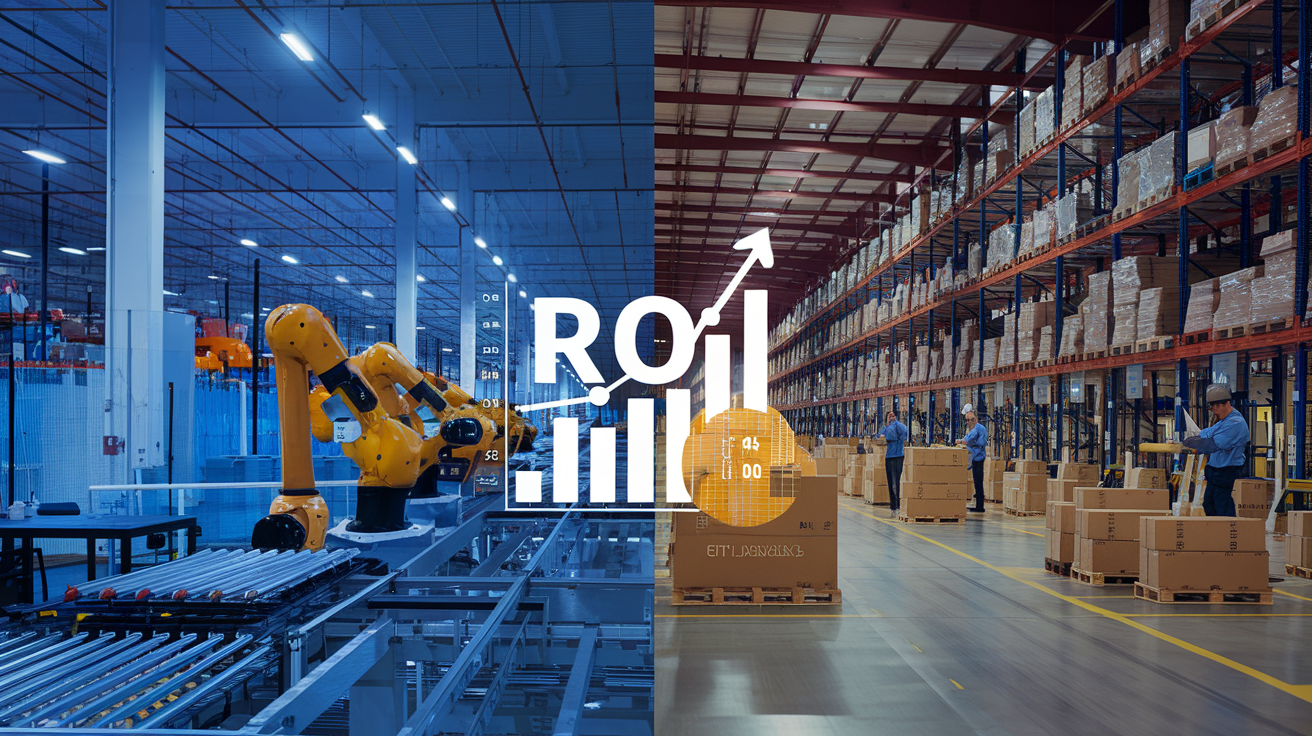
A. Initial investment for automation vs. manual setup
When comparing warehouse automation to manual operations, the initial investment is a crucial factor. Automated systems typically require a higher upfront cost, including equipment, software, and installation. In contrast, manual setups have lower initial expenses, primarily focusing on basic equipment and workforce recruitment.
| Investment Type | Automation | Manual Operations |
|---|---|---|
| Equipment | High | Low to Moderate |
| Software | Moderate | Low |
| Installation | High | Low |
| Training | Moderate | Low to Moderate |
| Workforce | Low | High |
B. Long-term operational expenses
Long-term costs differ significantly between automated and manual warehouses:
- Labor costs: Lower for automated systems, higher for manual operations
- Maintenance: Higher for automated equipment, lower for manual tools
- Energy consumption: Generally higher for automated systems
- Upgrades and replacements: More frequent and costly for automated systems
C. Potential return on investment
The ROI for warehouse automation can be substantial, but it takes time to realize:
- Increased productivity and throughput
- Reduced labor costs and human error
- Improved inventory accuracy
- Enhanced customer satisfaction
Manual operations may show quicker returns due to lower initial costs but often have limited growth potential.
D. Cost-benefit analysis tools
To determine the best approach, consider using:
- Net Present Value (NPV) calculations
- Payback period analysis
- Total Cost of Ownership (TCO) models
- Sensitivity analysis for variable factors
These tools help quantify the financial impact of each option, considering both short-term and long-term scenarios. When evaluating automation vs. manual operations, it’s crucial to factor in your specific business needs, growth projections, and industry trends.
Scalability and Flexibility

Adapting to business growth with automation
Warehouse automation systems offer significant advantages when it comes to scalability. As businesses grow, automated solutions can easily handle increased order volumes and inventory complexity without a proportional increase in labor costs.
- Automated storage and retrieval systems (AS/RS) can be expanded vertically
- Conveyor systems can be extended to cover larger areas
- Software upgrades can enhance system capabilities without major hardware changes
| Automation Feature | Scalability Benefit |
|---|---|
| AS/RS | Increases storage density by up to 85% |
| Conveyors | Can handle 2000+ items per hour |
| WMS Software | Manages millions of SKUs efficiently |
Flexibility of manual operations
While automation excels in scalability, manual operations often provide greater flexibility, especially for businesses with frequently changing product lines or seasonal fluctuations.
- Easy to adjust processes for new products or packaging
- Workforce can be quickly trained for new tasks
- Lower initial investment allows for more frequent operational changes
Manual operations can adapt more readily to sudden changes in demand or product mix, making them ideal for businesses with unpredictable growth patterns.
Hybrid solutions for balanced scalability
Many warehouses are now adopting hybrid solutions that combine the best of both worlds. This approach allows businesses to:
- Automate high-volume, consistent processes
- Maintain manual operations for variable or complex tasks
- Gradually introduce automation as the business grows
By strategically implementing automation alongside manual processes, warehouses can achieve a balance of scalability and flexibility that suits their unique needs and growth trajectory.
Warehouse Size and Complexity Considerations
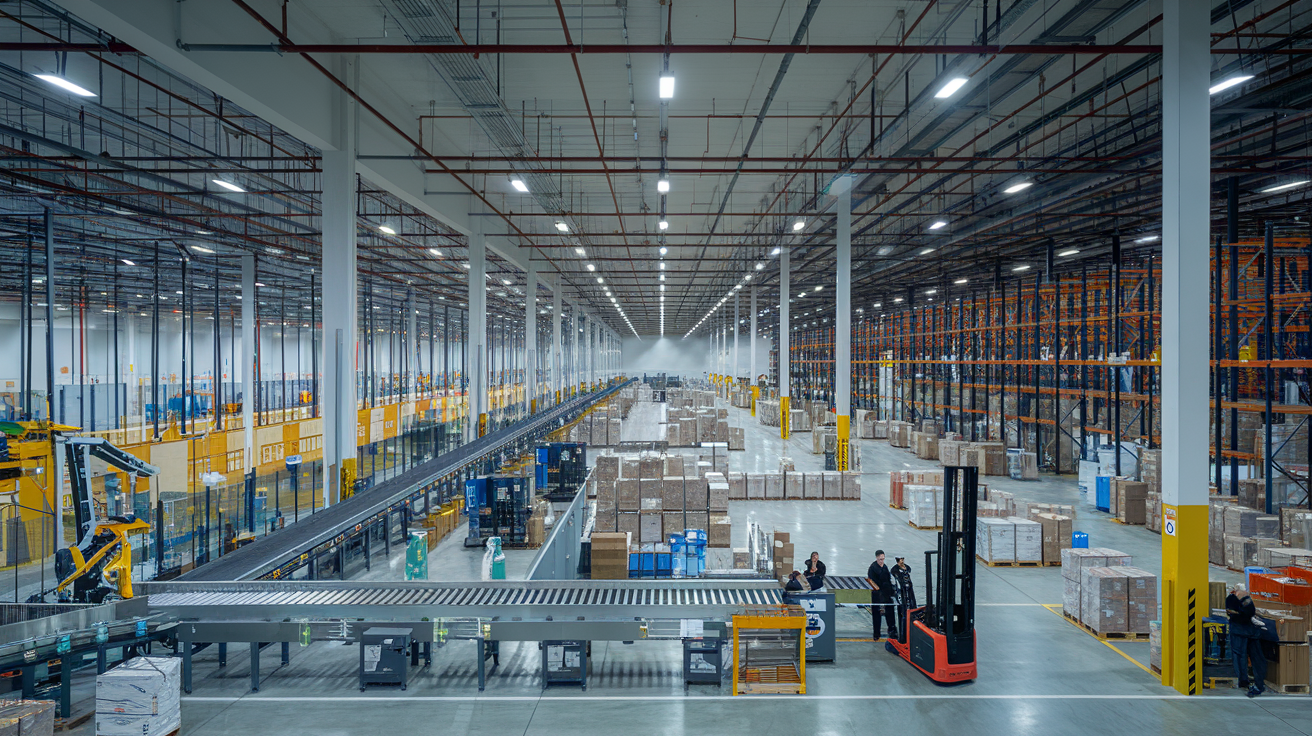
Automation for large-scale operations
Large-scale warehouses benefit significantly from automation due to their high volume of operations and complex logistics. Automated systems can efficiently manage vast inventories, reducing errors and increasing throughput. For instance:
- Automated Storage and Retrieval Systems (AS/RS)
- Robotic Order Picking
- Conveyor Systems
- Automated Guided Vehicles (AGVs)
These technologies excel in handling large quantities of goods, minimizing human intervention, and optimizing space utilization.
| Automation Feature | Benefit for Large Warehouses |
|---|---|
| AS/RS | Maximizes vertical space |
| Robotic Picking | Increases order accuracy |
| Conveyor Systems | Improves product flow |
| AGVs | Enhances flexibility |
Manual efficiency in smaller warehouses
Smaller warehouses often find manual operations more cost-effective and adaptable. The lower volume of goods and simpler logistics allow for efficient human-driven processes. Key advantages include:
- Lower initial investment
- Easier training and implementation
- Greater flexibility for changing product lines
- Personal touch for specialized or delicate items
Complexity of inventory and product types
The nature of inventory significantly influences the choice between automation and manual operations. Complex inventories with diverse product types may require a hybrid approach:
- Automated systems for high-volume, standardized items
- Manual handling for unique, fragile, or irregularly shaped products
- Semi-automated processes for items requiring quality checks
As warehouse complexity increases, the potential benefits of automation grow. However, the decision must balance efficiency gains against implementation costs and the need for flexibility in handling varied product types.
Impact on Workforce
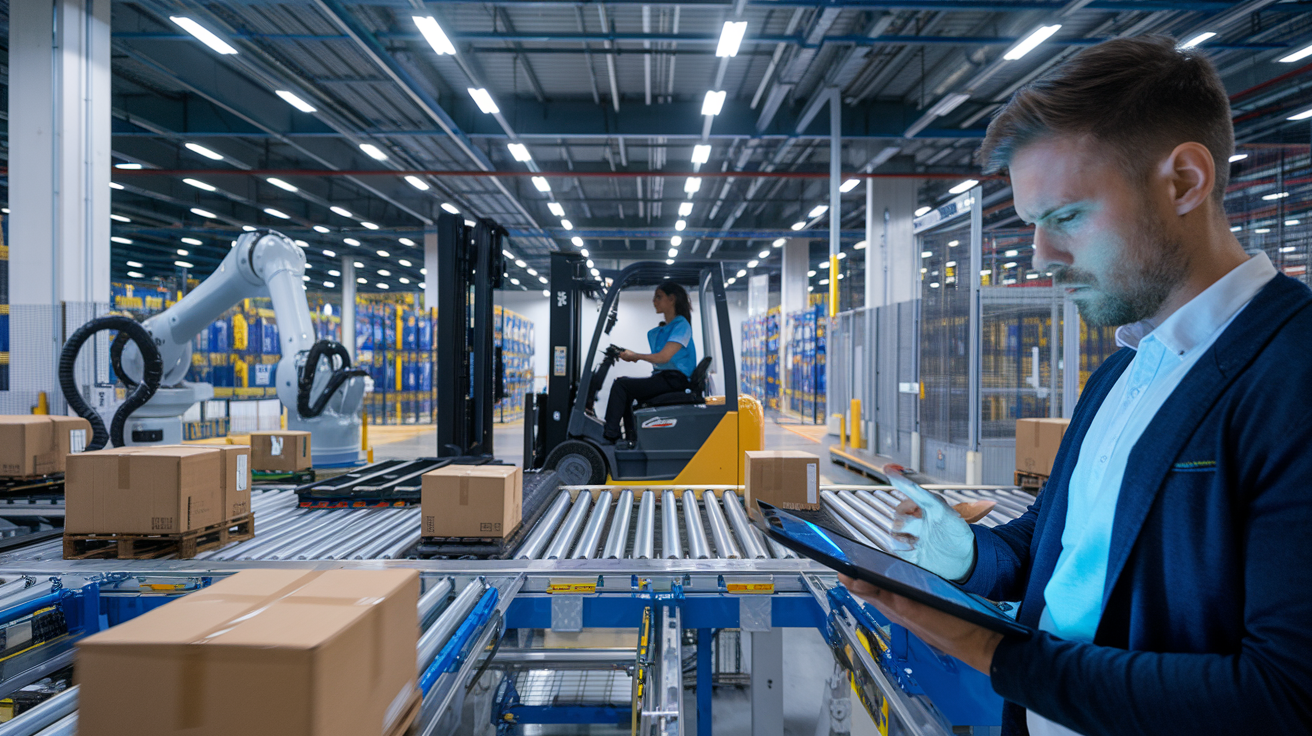
Job roles in automated warehouses
In automated warehouses, traditional roles evolve to incorporate technology-driven responsibilities. Key positions include:
- Automation Technicians
- Systems Analysts
- Data Scientists
- Robotic Process Operators
- Inventory Control Specialists
| Role | Primary Responsibilities |
|---|---|
| Automation Technician | Maintain and repair automated systems |
| Systems Analyst | Optimize warehouse management software |
| Data Scientist | Analyze operational data for efficiency improvements |
| Robotic Process Operator | Oversee and manage robotic systems |
| Inventory Control Specialist | Monitor stock levels using automated tracking systems |
Skills required for manual operations
Manual warehouse operations demand a different skill set, focusing on physical abilities and traditional logistics knowledge:
- Physical stamina and strength
- Attention to detail
- Basic math and inventory management skills
- Forklift operation and safety awareness
- Time management and organizational skills
Training and adaptation challenges
The shift towards automation presents several challenges:
- Upskilling existing workforce
- Attracting tech-savvy talent
- Overcoming resistance to change
- Balancing human-machine collaboration
- Continuous learning to keep pace with technological advancements
Employee satisfaction and retention
Automation can significantly impact employee satisfaction and retention in both positive and negative ways:
- Reduced physical strain and improved safety
- Opportunities for skill development and career advancement
- Potential job insecurity due to automation
- Increased job satisfaction through more engaging, tech-oriented roles
As warehouses evolve, the workforce must adapt to new technologies and processes. The next section will explore how automation affects speed and accuracy in warehouse operations.
Speed and Accuracy

Automated systems for faster processing
Automated systems revolutionize warehouse operations by dramatically increasing processing speeds. These systems utilize advanced technologies such as conveyor belts, robotic arms, and automated guided vehicles (AGVs) to streamline tasks like picking, sorting, and packing.
| Task | Manual Speed | Automated Speed | Improvement |
|---|---|---|---|
| Order Picking | 60-80 items/hour | 300-1000 items/hour | Up to 1150% |
| Sorting | 150-200 items/hour | 3000-6000 items/hour | Up to 2900% |
| Packing | 100-120 orders/hour | 400-700 orders/hour | Up to 480% |
Human precision in manual operations
While automation excels in speed, human workers still play a crucial role in tasks requiring judgment and adaptability. Manual operations benefit from:
- Problem-solving skills
- Handling delicate or irregular items
- Quality control and inspection
- Customer service interactions
Error rates comparison
Automation significantly reduces error rates in warehouse operations:
- Manual operations: 1-3% error rate
- Automated systems: 0.1-0.5% error rate
This improvement leads to:
- Fewer returns and exchanges
- Increased customer satisfaction
- Reduced costs associated with errors
Meeting customer expectations
In today’s fast-paced market, meeting customer expectations is paramount. Automated systems help warehouses:
- Process orders 24/7
- Offer same-day or next-day delivery
- Provide real-time inventory updates
- Handle peak seasons more efficiently
By combining the speed of automation with the precision of human oversight, warehouses can significantly enhance their ability to meet and exceed customer expectations. This hybrid approach allows for faster processing times while maintaining the flexibility to handle unique situations that may arise.
Implementation and Integration
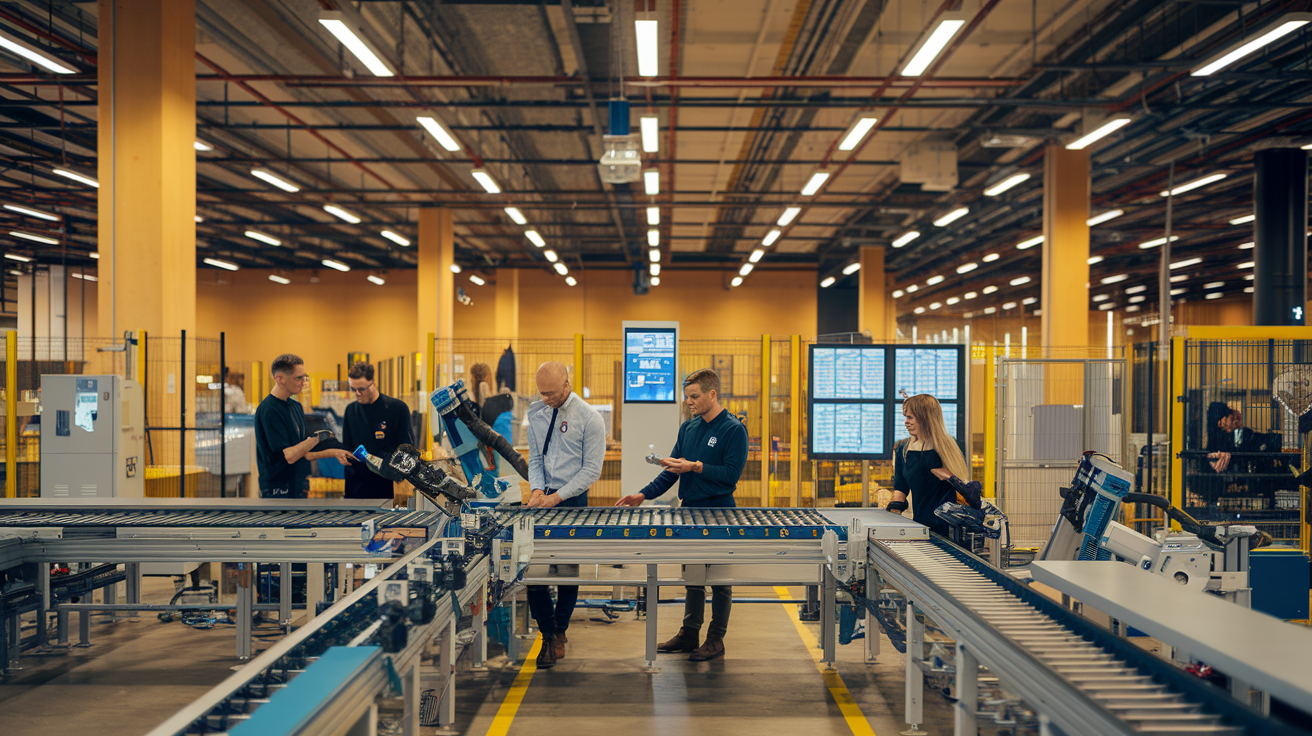
A. Time required for automation setup
Implementing warehouse automation is a significant undertaking that requires careful planning and execution. The time required for automation setup can vary widely depending on the complexity of the system and the size of the warehouse. On average, businesses can expect the following timeline:
| Phase | Duration |
|---|---|
| Planning and design | 2-4 months |
| Installation | 3-6 months |
| Testing and troubleshooting | 1-2 months |
| Staff training | 1-3 months |
It’s crucial to factor in potential delays and unforeseen challenges when estimating the timeline for automation setup.
B. Integrating automated systems with existing processes
Integrating automated systems with existing processes is a critical step in warehouse automation. This process involves:
- Analyzing current workflows
- Identifying areas for automation
- Customizing automation solutions
- Ensuring seamless communication between new and existing systems
A phased approach to integration can help minimize disruptions and allow for smoother adoption of new technologies.
C. Training staff for new technologies
Staff training is essential for the successful implementation of warehouse automation. Key aspects of training include:
- Familiarizing employees with new equipment and software
- Teaching safety protocols for working alongside automated systems
- Developing new skills for managing and maintaining automated processes
- Providing ongoing support and refresher courses
Investing in comprehensive training programs ensures that staff can effectively leverage new technologies, maximizing the benefits of automation.
D. Maintaining manual operations during transition
During the transition to automation, it’s crucial to maintain manual operations to ensure business continuity. This involves:
- Gradually phasing out manual processes as automated systems come online
- Cross-training staff to handle both manual and automated tasks
- Implementing temporary workarounds for areas undergoing automation
- Regularly assessing the transition progress and adjusting strategies as needed
By carefully managing the transition period, warehouses can minimize disruptions and maintain productivity while implementing automation solutions.

Choosing between warehouse automation and manual operations is a critical decision that can significantly impact your business’s efficiency, costs, and long-term success. While automation offers benefits like increased speed, accuracy, and scalability, manual operations provide flexibility and lower initial costs. The right choice depends on various factors, including your warehouse size, complexity, budget, and future growth plans.
As you evaluate your options, consider the unique needs of your business and the potential return on investment. Whether you opt for automation, stick with manual processes, or implement a hybrid approach, the key is to align your warehouse operations with your overall business strategy. By carefully weighing the pros and cons of each approach, you can make an informed decision that optimizes your warehouse performance and positions your company for future success in the ever-evolving supply chain landscape.

